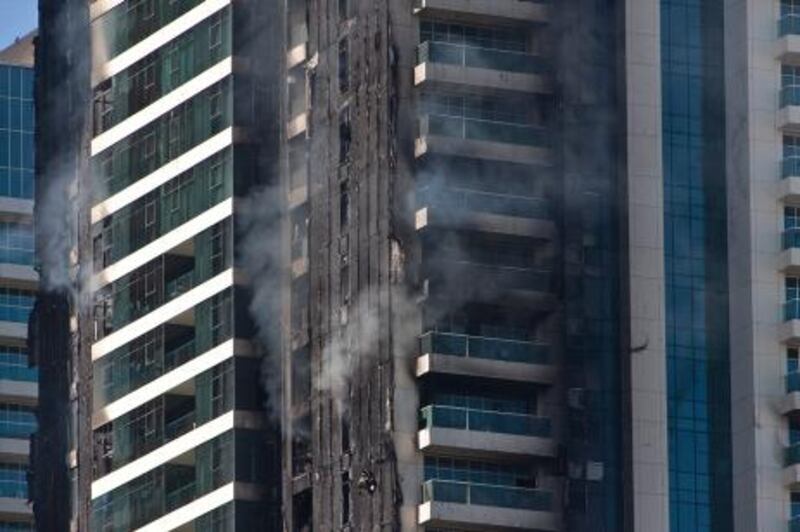DUBAI // An investigation into yesterday's fire at Dubai's Tamweel Tower is likely to centre on whether building materials helped fuel the blaze.
Although the cause has yet to be determined, the fire is believed to have started on or near the roof of the 34-floor building in Jumeirah Lakes Towers in the early hours of yesterday, before moving down most of the tower's east side.
Hundreds of people were immediately evacuated as firefighters battled for hours to bring the fire under control. Nobody was injured.
Sandy Dweik, of Thomas Bell-Wright International Consultants, said the speed of the blaze was likely to have been accelerated by the type of cladding used on the tower.
"The fire appears to have started on or near the crown at the top of the building, which was covered in this cladding," she said.
"The fire then spread down to the cladding, which is installed in strips running down the side of the building.
"The cladding acted as a fuel and this resulted in the damage we have seen."
She said the height of the tower would have made it difficult for firefighters to tackle the blaze because it was so high.
The cladding is believed to have been made with a combustible thermoplastic core sandwiched between two sheets of aluminium - the same type used on around 70 per cent of high-rise building façades in the UAE.
Several videos of the fire that were posted on YouTube clearly show flaming pieces of cladding falling from the building.
John Stead, from Britain, said a flaming piece of cladding landed on his neighbour's 32nd-floor balcony, causing a large portion of the living room to catch fire.
He helped his neighbour try to extinguish the blaze using a hose from the corridor.
"We rolled it out, but there was no water in the pump," he said. "At that point we saw the fire catch on the lower part of the building and decided it was a good idea to leave as soon as possible."
He added that there was no sprinkler operating.
Residents speculated that the initial cause of the blaze could have been anything from a candle left burning on the top floors of the building to an exploded gas container.
Most apartments in the building are thought to have electric cookers but a small minority use gas canisters.
A Tamweel official, who declined to be named, said it was too early to draw conclusions without a detailed Civil Defence investigation.
"We're still waiting for a laboratory report, which will be issued after a full investigation," he said. "It will take time."
Highly flammable cladding on the exterior of buildings has been blamed for several recent tower blazes, including one last month in the 13-storey Saif Belhasa building in Tecom.
In April, the 40-floor Al Tayer Tower in Sharjah was gutted in a fire that was believed to have been fuelled by aluminium cladding.
[ nhanif@thenational.ae ]
[ mcroucher@thenational.ae ]






